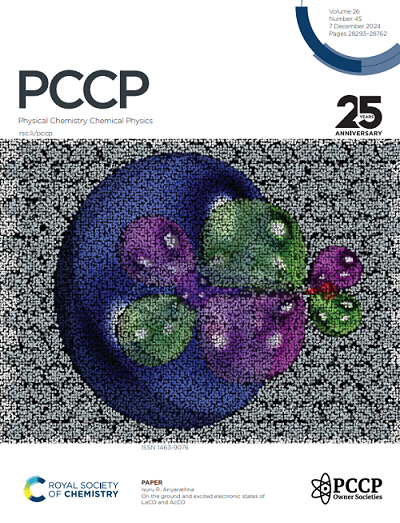Effect of Back Skeleton Ligand on Ultrafast Excited-state Dynamics of Cu(I) Cyano Substituted Bipyridine Complexes
IF 2.9
3区 化学
Q3 CHEMISTRY, PHYSICAL
引用次数: 0
Abstract
Cu(I) complexes have attracted a lot of research interest for their potential replacement of functional noble metal complexes. In previous researches of Cu(I) complexes’ ultrafast dynamics, most of the acceptor ligands used are symmetric and only a limited number of asymmetric ligands examples were reported. To further understanding the ultrafast excited states’ dynamics of Cu(I) complexes with asymmetric cyano-substituted bipyridine electron acceptors ligand, Cu(I) complexes with 6-cyano-2,2ʹ-bipyridine and 4,4ʹ-dimethyl-6-cyano-2,2ʹ-bipyridine ligand in dichloromethane and acetonitrile were investigated by applying femtosecond time-resolved transient absorption (TA) spectroscopy. From the TA spectra, it was found that there are two different metal-to-ligand charge transfer (MLCT) states with different nature could be populated after pseudo-Jahn-Teller distortion. Time-dependent density functional theory (TD-DFT) calculation results also support this hypothesis that in one MLCT state, electron density is donated from Cu(I) center to the cyanobipyridine ligand with electron density delocalised on the whole bipyridine ligand and in the other MLCT state is with electron density donated from Cu(I) center to the cyano-substituted pyridine fragment of the cyanobipyridine ligand. This result indicates that asymmetric electron acceptors may lead to extra excited states could be populated comparing with symmetric electron acceptors.求助全文
约1分钟内获得全文
求助全文
来源期刊

Physical Chemistry Chemical Physics
化学-物理:原子、分子和化学物理
CiteScore
5.50
自引率
9.10%
发文量
2675
审稿时长
2.0 months
期刊介绍:
Physical Chemistry Chemical Physics (PCCP) is an international journal co-owned by 19 physical chemistry and physics societies from around the world. This journal publishes original, cutting-edge research in physical chemistry, chemical physics and biophysical chemistry. To be suitable for publication in PCCP, articles must include significant innovation and/or insight into physical chemistry; this is the most important criterion that reviewers and Editors will judge against when evaluating submissions.
The journal has a broad scope and welcomes contributions spanning experiment, theory, computation and data science. Topical coverage includes spectroscopy, dynamics, kinetics, statistical mechanics, thermodynamics, electrochemistry, catalysis, surface science, quantum mechanics, quantum computing and machine learning. Interdisciplinary research areas such as polymers and soft matter, materials, nanoscience, energy, surfaces/interfaces, and biophysical chemistry are welcomed if they demonstrate significant innovation and/or insight into physical chemistry. Joined experimental/theoretical studies are particularly appreciated when complementary and based on up-to-date approaches.
 求助内容:
求助内容: 应助结果提醒方式:
应助结果提醒方式:


